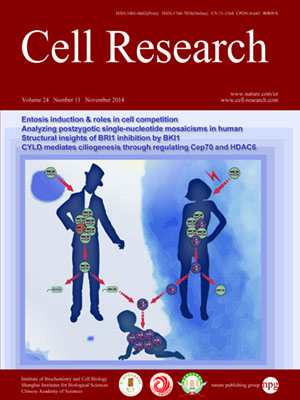
Volume 24, No 11, Nov 2014
ISSN: 1001-0602
EISSN: 1748-7838 2018
impact factor 17.848*
(Clarivate Analytics, 2019)
Volume 24 Issue 11, November 2014: 1367-1369
LETTERS TO THE EDITOR
Epicardium-to-fat transition in injured heart
Qiaozhen Liu1, Xiuzhen Huang1, Jin-Hee Oh2, Ruei-Zeng Lin3, Shengzhong Duan1, Ying Yu1, Rui Yang4, Ju Qiu4, Juan M Melero-Martin3, William T Pu5 and Bin Zhou1
1Key Laboratory of Nutrition and Metabolism, Institute for Nutritional Sciences, Shanghai Institutes for Biological Sciences, Graduate School of the Chinese Academy of Sciences, Chinese Academy of Sciences, Shanghai 200031, China
2Department of Pediatrics, The Catholic University of Korea, Seoul, Korea
3Department of Cardiac Surgery, Boston Children's Hospital, and Department of Surgery, Harvard Medical School, Boston, MA 02115, USA
4Institute of Health Sciences, Shanghai Institutes for Biological Sciences, Chinese Academy of Sciences & Shanghai Jiao Tong University School of Medicine, Shanghai 200025, China
5Harvard Stem Cell Institute, Harvard University, Cambridge, MA 02138, and Department of Cardiology, Boston Children's Hospital, 300 Longwood Avenue, Boston, MA 02115, USA
Correspondence: Bin Zhou,(zhoubin@sibs.ac.cn)
The origin of fat cells or adipocytes is a fundamental biological question with important ramifications for human health and disease1. Epicardial fat is associated with increased risk of cardiovascular diseases such as coronary atherosclerosis2. However, the origin of these epicardial fat cells remains largely unknown. Epicardial progenitors play a pivotal role in the developing heart, by secreting paracrine signals and by differentiating into fibroblasts, smooth muscle cells, and potentially endothelial cells and cardiomyocytes3,4,5,6. Some of these developmental programs are reactivated during postnatal heart injury7,8, and reactivated adult epicardial progenitors provide pro-angiogenic protection and undergo limited epithelial-to-mesenchymal transition in cardiac injury7,9. Since epicardial fat is physically adjacent to epicardial cells, we hypothesized that some of these cells originate from the epicardium during development and in postnatal heart injury.
10.1038/cr.2014.125
FULL TEXT | PDF
Browse 2438


